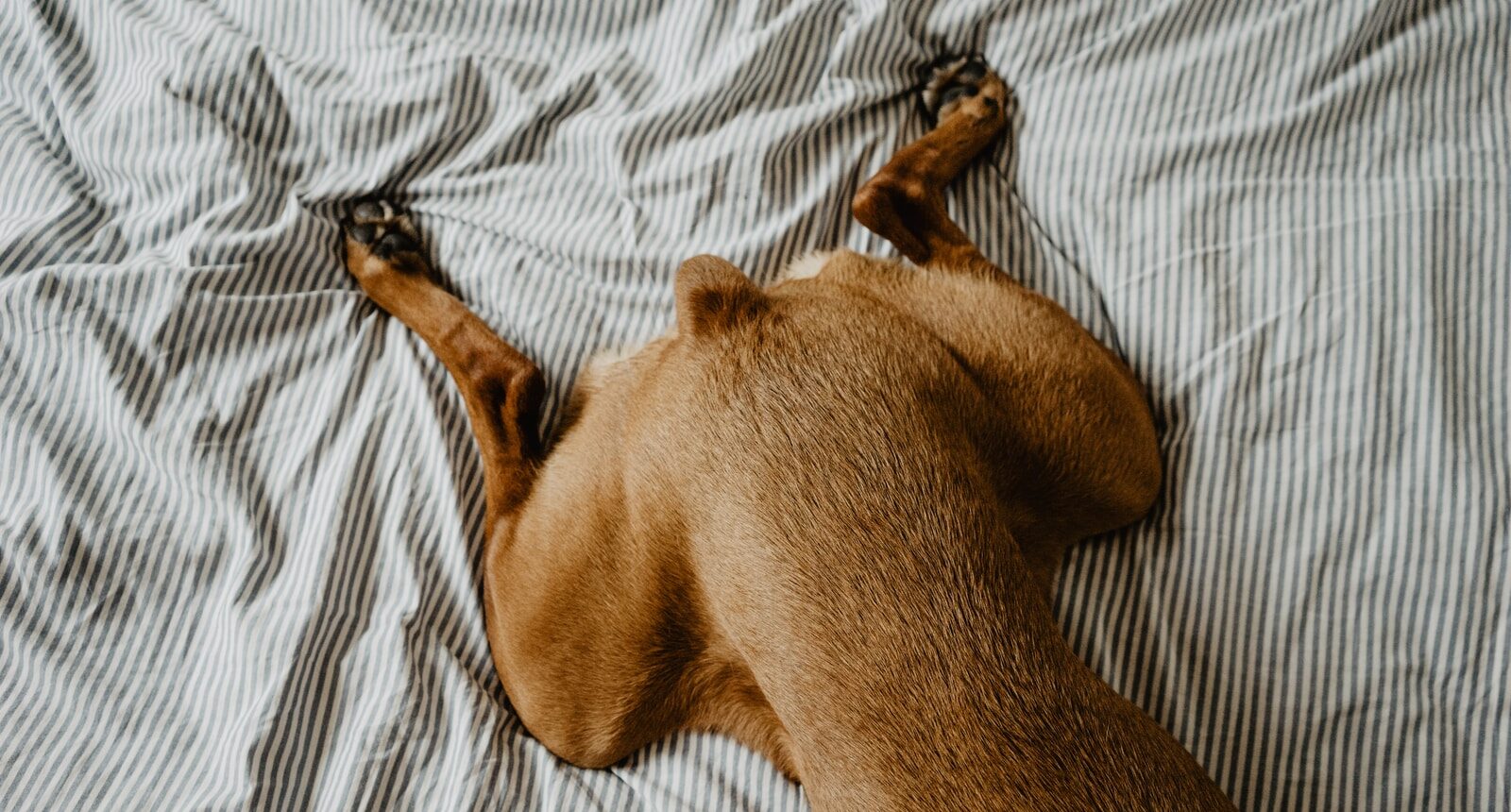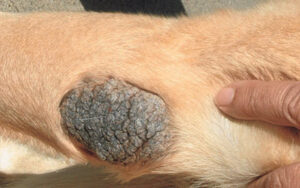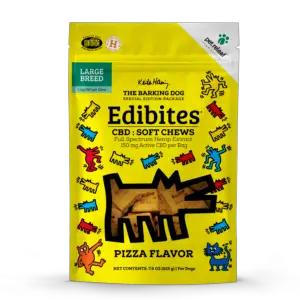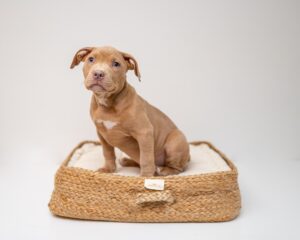
Key points
- Dog elbow callus is a condition during which the skin on your dog’s elbows, hips, sternum, hocks, and the side of the legs becomes more rough and appears in dark brown, black, or grey color. A callus is a localized hyperplastic skin reaction a pet’s body uses to protect the bony protrusions from pressure.
- Large breed dogs with short coats such as Great Danes, Labrador Retrievers, Mastiffs, and Rottweilers are more prone to developing elbow calluses. Short breeds such as Dachshunds, Pointers, Shetland Sheepdogs, Boxers, and Doberman Pinschers can often develop calluses on the chest.
- If left untreated, calluses can result in pyoderma (an infection) or hydromas (fluid pockets), which can cause your dog a lot of pain.
- VitaminA can be effective at managing dog elbow callus since it works with the endocannabinoid system in the dog’s body to promote healthy skin and fur.
If you’re reading this article, you may have seen rough, unpleasant-looking patches on your dog’s elbows and wondered what they are. Just like when humans wear uncomfortable shoes, a dog’s skin tends to become more rough when it’s in contact with hard surfaces, and over time this skin turns into a callus.
Statistics show that about 20% of dogs suffer from elbow callus at some point in their lives, regardless of their breed. This condition is usually not painful and not life-threatening to your dog, but it can be quite uncomfortable to live with. In some cases, if a dog’s elbow callus is left untreated, it results in cracks and bleeding, making it easy for infection to step in. In this article, we’ll give you some tips for managing your dog’s calluses and alleviating your pup’s discomfort.
Table of Contents
Dog Elbow Callus: What Is It?

Dog elbow callus, which is often referred to as pressure sores, is a condition that occurs when a dog’s body tries to protect bony protrusions from pressure. These calluses appear as round or oval hyperkeratotic plaque in sites of bony protrusions. Dog elbow callus can affect one or several spots on your dog’s body. The skin in these areas becomes thicker, which causes the hair to fall off, revealing rough skin.
Causes Of Elbow Callus In Dogs
If your dog regularly lays down on hard surfaces, it puts extra pressure on its elbows and other parts of the body, including hips, sternum, hocks, and the sides of the legs. Calluses are essentially a natural bodily response to that extra pressure, as they appear to protect the skin around bony protrusions.
In some dogs, calluses appear dark brown and black, while in others, they are gray. It usually depends on your dog’s skin color and the length of time it has been suffering from calluses.
If there aren’t any underlying issues causing the condition, then your dog’s elbow calluses are probably caused by one of the following:
- Frequently lying on hard surfaces;
- Obesity or extremely low weight;
- Hypothyroidism;
- Orthopedic problems associated with pain that forces your pup to rest all the time.
Can Dogs Be Predisposed To Developing Elbow Calluses?
Large breeds with short coats are more likely to get elbow calluses because they weigh more and therefore put more pressure on their elbows while laying down. These breeds include Great Danes, Labrador Retrievers, Mastiffs, and Rottweilers. Some smaller breeds can also get calluses on their sternums. These include Dachshunds, Pointers, Shetland Sheepdogs, Boxers, and Doberman Pinschers.
Elbow Callus Complications
Calluses can become itchy and irritated, so it’s essential to start treating them as soon as you notice any affected spots on your dog’s body. If you don’t address the issue right away, calluses will grow in size and become more dangerous over time. There are several possible complications that are associated with calluses:
Pyoderma
Sometimes, dogs can chew and scratch the affected areas, resulting in cracks on the skin surface. That will easily allow Staphylococcus bacteria to enter the body and provoke a callus pyoderma – a painful infection that causes itchiness and hair loss. Fistulation ulceration and exudative discharge may also occur. If pyoderma is not treated in a timely manner, your pet may develop further complications, including:
- Dermatophytosis
- Neoplasia
- Decubital ulceration
- Demodicosis
- Other causes of deep pyoderma
If your pet has an elbow callus, it’s likely to develop a bacterial infection. Seek veterinary attention if you see any cracks, bleeding, or scaling on the skin.
Pyoderma Treatment Plan
- Find out the underlying cause;
- If the pyoderma is deep, your pup will need to take antibacterial agents;
- Besides systemic therapy, topical therapy with chlorhexidine/miconazole will be necessary. You can continue applying these medications even after the pyoderma has healed as a preventive treatment;
- Try running whirlpool baths for your pup;
- Provide your dog with a comfortable bed and protective dressing for the calluses.
Hygromas
Hydromas are fluid pockets that develop in your dog’s elbows. Hydromas can occur instead of elbow callus or together with it. If a hydroma is not infected, a veterinarian will drain it, and then you will simply need to keep your pup away from hard surfaces. However, if your dog has an infected hygroma, it can cause your pet a great deal of pain. Surgery may be necessary to cure the condition.
Home Remedies For Canine Elbow Calluses
While elbow calluses usually aren’t dangerous, we don’t want our furry companions to experience discomfort or pain. So here are a few tips that will help you to prevent elbow calluses in your dog or alleviate the condition if your pup already has them.
Provide Your Dog With A Soft Bed
No matter how comfortable their bed may be, many dogs still choose to sleep on cool and hard surfaces. If your dog often rests on the floor, try to encourage it to choose its bed instead by rewarding the pet with treats and your affection every time it goes to sleep or lies down in its bed. If your dog likes to sleep outside during hot summer days, consider buying an elevated bed or one with a cooling pad.
Add Vitamin E To Your Dog’s Diet
Vitamin E helps to fight free radicals and contributes to healthy and shiny skin and coat. You can add vitamin E to your dog’s food, but it will be more effective to apply it directly to its skin.
Petroleum Jelly
Petroleum jelly is made up of a combination of waxes and mineral oils. It seals your dog’s skin with a barrier that keeps the skin moisturized and healthy. Make sure you apply petroleum jelly (Vaseline) to all the affected areas and thoroughly massage the product into your dog’s callus. Apply this product every 12 hours for a week, and after that, continue with one daily application to soothe and moisturize the skin.
Coconut oil and other elbow balms can also help soothe dry skin and relieve itchiness. If you do these small steps, it’ll be very easy for you to eliminate your dog’s calluses.
VitaminA
Many pet owners prefer to use natural remedies to treat cosmetic issues such as elbow calluses or dry paws. While minimizing the time that your dog spends on hard surfaces is important, you should also make sure that you moisturize your pup’s calluses and give them some time to heal.
VitaminA ointments and creams are a great option that will help to resolve the elbow callus issue quickly. VitaminA interacts with cannabinoid receptors in your dog’s body. These receptors are responsible for promoting skin health, among other things. It’s important to mention that VitaminA is safe for dogs and is widely used for many purposes, including treating skin conditions such as elbow callus.
FAQ
How do you treat calluses on a dog’s elbow?
You can get rid of elbow calluses by providing your dog with a comfortable bed and applying topical vitamin E, petroleum jelly, or another elbow balm to the callus regularly.
Will dog elbow calluses go away?
If your pet’s condition is not severe and you minimize or eliminate the time your pup spends on hard surfaces, it shouldn’t take long for the dog’s elbow callus to heal.
Why do dogs get hard skin on elbows?
Hard skin on a dog’s elbows is a callus, which the pet’s body develops to protect the bones that poke out of the skin.
Is it normal for dogs to get calluses?
Yes, about 20% of dogs have calluses at some point in their lives. It’s not a medical condition and can be easily treated at home if there’s no underlying issue.
How can I prevent my dog from getting calluses?
To prevent dog calluses, encourage your dog to rest and sleep on soft bedding instead of hard floors. Purchasing a padded or elevated bed for your pet may help to encourage it as well.
Can I put Vaseline on my dog’s elbows?
Yes, you can put Vaseline on your dog’s elbows. It’s not toxic and works well for soothing dry skin.








